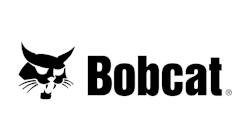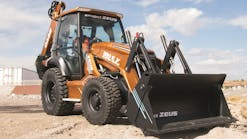Compact equipment is in greater demand today, and more widely used than ever before, particularly in the North American market. “It’s following in the footsteps of the skid steer,” believes John Comrie, product manager, mini excavators and compact wheel loaders, Volvo Construction Equipment. “It has become the ‘Swiss Army Knife’ on every job.”
While the skid steer loader and compact track loaders have historically been viewed as the “Swiss Army Knife” in the industry, roles are expanding for compact equipment, which can be used on many applications. The versatility of compact equipment is leading to its increasing presence on job sites. “It’s used everywhere,” says Comrie. “It’s an essential tool.”
For years, we’ve known that compact equipment is easy to move from job site to job site and has a tighter turning radius than big machines, which may be too cumbersome on some jobs. But now we’re seeing smaller equipment used on big jobs as well.
Versatility Leads to Popularity
“The compactness of these powerhouses allows them to be more versatile than the larger conventional full-size backhoe, and also take on larger projects when needed,” declares Tim Boulds, Kubota Tractor construction equipment product operations manager.
Instead of a single backhoe loader on a job site, now there may be a skid steer or compact track loader and mini excavator. “You can haul these two pieces of equipment together,” explains Warren Anderson, product manager–excavators and dumpers for Wacker Neuson, adding that on the job site they can be working in parallel, versus the backhoe loader, which can use the bucket or backhoe, but not both.
The role of compact skid steers, excavators, and track loaders is expanding because they are so versatile. That versatility is increasing their popularity in segments like farming, mining, demo, road building, and snow removal. In particular, the utility sector has seen substantial growth.
A JCB skid steer with a general purpose bucket
“We’re still learning about their versatility and value,” states Gregg Zupancic, product marketing manager for John Deere Construction and Forestry.
Some of the versatility comes from the smaller size. Compact equipment can be transported with a pickup truck and trailer that doesn’t require a CDL. Once on the job site, compact and mini equipment can work indoors, unlike their full-size counterparts. Even outside, their footprint is smaller, allowing them to maneuver around obstacles more easily.
“The vast majority of operations have restrictions,” points out Anderson.
“The smaller machines can navigate through tight job site entries and operate with more uptime in a confined space,” explains Brent Kuchynka, vice president of Corporate Fleet Management for United Rentals Inc. “The demand has helped drive the evolution of more versatile machinery that’s easier to transport and more affordable to own or rent. The mini excavator is a good example of a category that’s taking over some market share from the standard backhoe.”
A JCB 320T grading on a work site
The versatility also comes from the broad range of attachments available. “That means contractors can complete a wide variety of jobs with a single, easily transportable machine,” says Vincent Whelan, vice president–compact products, JCB North America.
Many manufacturers are expanding the range of attachments offered for compact equipment. “Most likely there is an attachment made specifically for the task or project at hand,” says Boulds. He lists mowers, brooms, specialty buckets, saws, planers, breakers, thumbs, and yard rakes as a sample of attachments that are currently available for compact equipment. Attachments such as dozer blades, grading attachments, and broom attachments enable compact equipment to do many jobs traditionally performed by their larger counterparts.
Attachments and improved features that include dual auxiliary hydraulics, increased auxiliary flow with flow settings that can be adjusted from the operator’s seat, and the ability to program multiple attachments so they can be exchanged quickly and efficiently add to the versatility, according to Michael Shebetka, product manager for Takeuchi Mfg.
Simply put, attachments are in demand. Comrie refers to the popularity of an angle blade to backfill trenches and a laser system that can be fitted for grading.
Because attachments are so critical to the compact business, John Deere has been focusing heavily on its attachment business. “We have 100 styles,” says Zupancic, “many of which are geared for grading and excavating.”
Availability of attachments helps contractors save time and money. Productivity is another; the ability to move a lot of material quickly and perform a variety of tasks contributes to the demand for compact equipment.
The lower cost of ownership of compact equipment is another money saver. They are easy to operate, Zupancic contends. “They’re intuitive; there’s little training needed.”
In addition to using less fluids and requiring less maintenance, compact machines less than 74 horsepower don’t require after-treatment such as diesel exhaust fluid. “JCB compact equipment also does not require a diesel particulate filter, meaning that the engines are completely self-regenerating and as such drastically reduce downtime and service time on the machines,” says Whelan. “This is particularly important in the rental sector.”
The Job Market
The demand for compact equipment is growing due to such advantages. Compact excavators are being used on “all types of applications,” insists Comrie. They are a good alternative for the rubber-tire backhoe because they have the same dig depth, but have a 360-degree swing (compared with a backhoe’s 90), and are easy to transport.
He lists some jobs compact equipment often performs: moving or loading material to assist with new residential construction sites, prepping foundations for site work, helping dig trenches for cable and water lines, and installing or repairing utilities.
Expanding on Comrie’s list, Takeuchi’s Shebetka says compact equipment is found on the largest construction sites and the smallest do-it-yourself projects. “They can be seen digging footers and basements, working on road and bridge construction, performing utility installations, landscaping, pool construction, doing plumbing installations and repairs, in vegetation and forestry management, natural disaster clean-up, demolition, municipalities, and the list goes on.”
Applications run the gamut in the residential, commercial and industrial sectors, Kuchynka concurs. He credits development that has led to machines that are more comfortable, with a more ergonomic design, better visibility for the operator, and expanded safety features.
“They’re too versatile to be slotted into any one type of job,” he says. “We rent them for all kinds work.”
Utility contractors are using skid steers, compact track loaders and compact excavators for service upgrades and additions in urban areas. Residential and commercial contractors are using compact telehandlers and skid steers for materials handling on construction projects, JCB’s Whelan reports.
“The array of attachments available. . . ensures machines can thrive in more industries than ever before,” he says.
That’s important because contractors are always looking for ways to get more out of their machines to increase profits, Boulds indicates. The right attachments help. For example, Kubota’s Hydraulic Thumb Kit enhances excavator versatility.
“A hydraulic thumb is excellent for managing the manipulation of irregular-shaped objects, debris, rocks, and even logs,” he says. “Our Hydraulic Thumb Kit is also custom-designed to match bucket tip radius and is retractable for trenching.”
All Kubota excavators offer auxiliary hydraulics to the end of the dipper stick, some of which allow for a second set of auxiliary hydraulics. Various options and attachments are available, including hydraulic hammers, hydraulic tilt grading buckets, and augers. The Quick Coupler enables operators to switch tasks with speed and ease. Ultimately, he believes that the roles for compact equipment are expanding due to new and highly efficient hydraulic systems that show superior performance in breakout power and speed.
A Takeuchi TL12V2 gets dirty.
Tech Talk
Technology has made compact equipment more efficient and easier to use, service, and maintain. Telematics are being utilized more and more on today’s compact equipment, allowing service managers to monitor things like service, error codes, and movement from a distance.
This feature helps contractors and rental companies manage their fleets, track production and machine utilization, monitor machine health and maintenance intervals (which may extend the life of their machine), schedule downtime for maintenance, and help in the recovery of stolen assets, according to Shebetka.
Last year, JCB introduced “myCHOICE” controls on skid steers and compact track loaders. Whelan explains that it’s a special control software that allows operators to customize the machine’s controls to their specific preferences. “We expanded the control system from three control modes to six: three for the transmission and three for the loader functions,” he says.
JCB compact loaders will keep improving because of the ability to upgrade myCHOICE through software updates performed by the dealer. The option of LiveLink on compact equipment provides information such as idle time monitoring and machine fuel consumption, which helps reduce fuel usage, save money, and improve productivity.
“All JCB controls are straight forward and easy to use, allowing for parameters on auxiliary flow to be set, and auto idle programmed with just a few simple switches in the cab,” concludes Whelan.
Similarly John Deere compact equipment features electro-hydraulic technology—software and computer systems to drive the hydraulic system. “It matches the customer’s skill level and familiarity,” explains Zupancic.
The EH joystick control system offers three options: drive with your hands, drive with your hands and feet, and an H pattern. “There are options to speed up or slow down: productivity mode, precision mode, and utility mode.” The options pertain to both loader and bucket speeds.
Kubota’s KX040-4 compact excavator features something comparable—ECO PLUS, a technology that allows the operator to prioritize productivity or fuel efficiency based on the task at hand. With this feature, operators can select Standard Mode for increased power and productivity or ECO Mode can be activated with a flip of a switch for up to 9% fuel savings. The KX040-4 has a 42.4 gross horsepower engine, a dumping height of 12 feet 9.5 inches, and a digging depth of 11 feet 2.6 inches.
Wacker’s low-effort Electro-Hydraulic control reduces fatigue after eight hours in the cab. It’s an important feature because operators are in the cab longer than they used to be. Push-button pattern changers allow multiple operators to operate the same unit in their preferred pattern. External cameras with bigger cab displays increase visibility and safety on the job site.
Some of the biggest advancements have been in the areas of ease-of-serviceability, improved cycle times, versatility of attachments, GPS devices, and safety features. “Backup alarms, beacons, and seat belt sensors are now standard on most of this equipment, which is a good thing because the smaller units can sometimes appeal to less-experienced operators,” believes Kuchynka, adding, “When someone rents one of these units from us, we make sure they understand the safe operating procedures, regardless of their level of experience.”
For Sale or Rent
Rental houses make up 60% of the market, Comrie states. He blames the economy for lack of sales. “People just aren’t buying the way they used to. When you rent, it protects you from a machine sitting during slow times.” For that reason, he says, rental at dealerships is also on the rise.
Of course, he continues, there are benefits to renting versus owning. “Renting allows the customer to select the exact size machine, any attachments required, and different buckets they may need for the job.”
Rental provides balance for asset management during the peaks and valleys of the business, but Zupancic thinks that if a contractor rents a piece of equipment for two weeks out of a month, he might as well own it. Maybe that’s why he says compact equipment purchases are up.
The Wacker Neuson trench roller at work
“Cost and versatility are driving it,” he explains. “Big equipment purchases are soft, flat in growth, but compact equipment sales are growing 10 to 20% per year.” He believes the availability of attachments, which creates more versatility, is contributing to the rise in sales.
Ultimately, the decision to own versus rent equipment often comes down to the needs of the contractor. As Zupancic pointed out, if a contractor only needs the equipment sporadically, then renting makes the most sense; however, if the equipment will be used often, then purchasing the unit should be considered.
The advantages of purchasing a machine are basically the “flip side” of renting. Some advantages of owning include less expense over the long term, possible tax benefits, availability of the machine, and return on investment, according to Kubota’s Boulds. A disadvantage to consider is the cost of repair and maintenance over the machine’s lifetime. The longer you own it, the more those costs increase.
Some advantages of renting include a lower initial investment, flexible payment options, access to new or state-of-the-art equipment, and no storage or maintenance fees, Boulds continues. When you’re done with rented equipment, you simply return it, without worrying about storage.
A potential disadvantage is that when you rent a piece of equipment, you are not building equity with it. The fact that equipment rental is not a capital investment can be a detriment or a benefit. If you rent, you don’t pay for service, failures, or malfunctions. However, you cannot write it off as a capital investment and get the tax benefit on the capital investment.
The disadvantages of renting, as Wacker’s Anderson sees them, include the cost. “It’s more expensive (per day or per hour) than if you owned it.”
Taking into consideration that you pay to service purchased equipment and for out-of-warranty repairs, it can still be cost-effective to own if you use the machine frequently. However, Anderson cautions, remember that “you still own the unit and need to make payments even if your upcoming job was canceled—and you must be concerned about resale.”
There’s the risk that the rental yard may not have what you want in stock the day you need it. If you own it, it’s always available when you need it.
“If you know you’re going to use a compact excavator, for example, quite a lot, purchasing one means you’ll never have to worry that your rental dealer won’t have one when you need it. It will be available for you at all times,” notes Whelan.
In addition, if you own the equipment, you spec it out exactly the way you want it with the features needed for your application. When you purchase a machine, you can choose the options and features you really want and need rather than being limited to a more standard rental unit. But if you rent, you do not get to choose the configuration or features that may suit your application the best.
There are a lot of things to consider when deciding whether to rent or own a piece of equipment, says Shebetka. Some key items to consider are:
- What type of financing is currently available?
- What is your cash flow situation?
- What kind of cash does the contractor have on-hand (reserves)?
- Does depreciation of the asset outweigh the ability to deduct rental payments?
- Will the equipment be utilized long-term or will it only be used from time to time as a need arises? Jobs/applications may change where the utilization rate for a piece of owned equipment may slow and become more sporadic or stop altogether.
- Is a rental purchase more prudent, which would allow a part of the rental paid to go towards the purchase of the equipment? It would also allow the machine to be turned back in at the end of the rental period if necessary.
In general, renting a machine is better if you’re not sure how much or how often you’ll be using a particular piece of equipment. One advantage of renting is that it gives you the opportunity to test out a machine and determine if you’ll use it often enough to justify spending the money to buy it, Whelan points out.
It’s important to consider all the factors when weighing renting against purchase: cost of ownership, length of the project, application, and safety all have a bearing, Kuchynka sums up. “Under cost of ownership you have the initial capital investment, insurance, storage, transport, operator training, repairs, maintenance, parts, and sale/disposal at the end of its useful life. It can really add up. That’s why, if a machine is going to be idle for blocks of time during the year, it’s better to rent it. With the pressure put on project budgets today, any strategy that saves money and increases productivity is worth considering.”
Or, as Anderson explains, “There is a somewhat simple way of looking at this, if you spend more renting in a season than it would cost you to own one, you may want to consider purchasing.
Compact Advantages
Whether you rent or own compact and mini equipment, there are undeniable advantages to using smaller machines on construction and grading projects. They are easy to operate and transport, Comrie begins. They have “smooth controls,” he adds. “The performance feels like you’re driving a big excavator.”
Volvo uses the same joystick configuration for large excavators as they do for compact models, which makes transitioning from one to the other uncomplicated. That means that it costs contractors less for training because of the similarities of operation.
Because they don’t weigh as much as their larger counterparts, compact machines do little damage to the terrain. Beyond their weight, Comrie says the machines are easier on the terrain because different types of track options.
“There’s steel for offsite, single rubber, bolt-on tough pads, and wider tracks or swamp pads, for soft ground,” he says.
When it comes to compact excavators, there are two types of customers, Comrie observes: those who want performance because they have a lot of material to move, and those who want compact size to fit in tight spaces.
Either way, Volvo has models to suit them, he says, such as the recently launched EC35D, a 7,500- to 8,000-pound machine that comprises the biggest segment of the industry, and the ECR40D, an 8,500- to 9,800-pound short-radius machine. Both models include a 10% increase in cab space over past models, making them the roomiest cabs in the industry, Comrie says. In general, he adds, all Volvo compact machines are “quiet and have big roomy cabs, more leg room, and ample storage.”
Volvo reduced horsepower on the EC35D and ECR40D from 36 to 24 while increasing performance in the way of lift capacity and break-out/tear-out force, he continues. Volvo’s “hydraulic regeneration system means the pump doesn’t have to work as hard to maintain the required oil flow; therefore, it requires less engine horsepower.”
Five new models introduced by John Deere this year are already getting good feedback on performance and power. The G series—four skid steers and a track loader—are on the smallest end of their lineup at less than five feet wide. “We didn’t have this segment in the past; it rounds out our lineup.” And addresses a “hot market,” he adds.
There’s high demand for all brands of mini and compact equipment. “The potential is unlimited,” concludes Zupancic.












